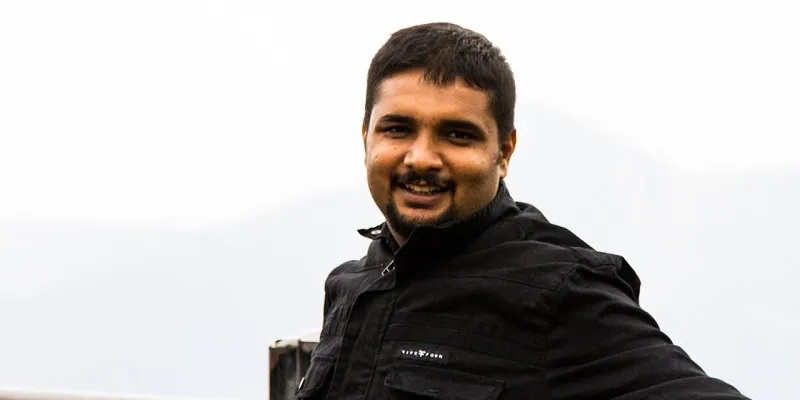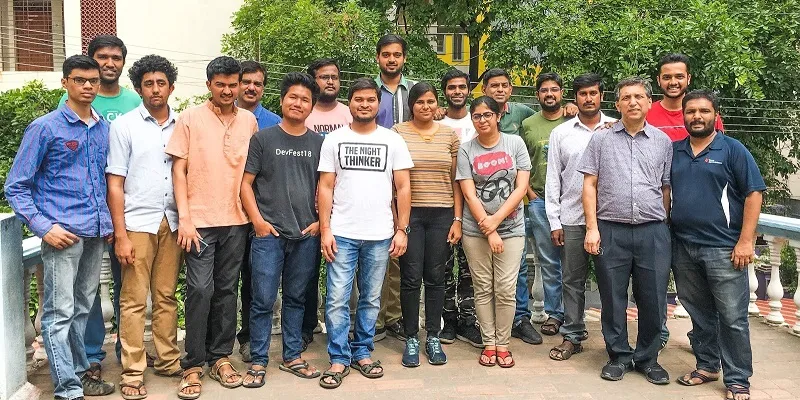[Techie Tuesday] How a farmer’s inability to get the best crop rate propelled Ananth Nagaraj to build speech recognition platform Gnani.ai
This week in our Techie Tuesday series, we speak to Gnani.ai Founder Ananth Nagaraj, whose belief in constant learning and love for communication helped him build the speech recognition platform.
At his first job, Ananth Nagaraj learnt an important lesson that has held him in good stead throughout his career and entrepreneurial journey so far: “One needs to have perseverance to solve complex things, and keep the learning curve going to be in the game.”
The 33-year-old, after working over a decade in the networks and communications space across multiple organisations, co-founded , a deep learning and speech recognition AI startup along with former colleague Ganesh Gopalan.

Ananth Nagaraj, Founder, Gnani.ai
Ananth has a simple mantra as an engineer: technology should make a user’s life easier. To this end, he strongly believes that voice is the future and that voice interfaces will reshape customer support, marketing, and sales operations in the coming years.
In this conversation with YourStory, Ananth takes us through his career highlights and what inspired him to build Gnani.ai.
A startup’s roots in sixth grade
Hailing from Bengaluru, Ananth spent most of his life in the city. His father was a veterinary doctor and his mother a government employee.
The techie’s first real tryst with the computer happened when he was in Class VI. He clearly recalls the day he learnt to build smaller applications that take inputs from the user and then print them across the screens.
From learning the basics to falling in love with programming languages, computer science had the youngster in raptures, making it his favourite subject in school.
“I personally believe I had started building that deep tech company back then. I was always fascinated by how the computer works,” Ananth laughs.
While pursuing engineering in Electronics and Communication at Visvesvaraya Technological University, Bengaluru, Ananth was intrigued by the engineering aspects of a computer.
“I was curious to understand how people could handle technology. This is why I joined a telecom company to help them set up the 4G networks,” he explains.
The 4G revolution
Looking back, Ananth says he derives great satisfaction and much learning from his first two jobs, where he got opportunities to build tech stacks in the network communications space.
After his engineering degree, he landed a job at Kyocera Wireless, a Japanese telecom company, in 2008.
In less than a year, he got the opportunity to be part of the team that was building a tech stack for 4G communications that would empower users.
“Kyocera India had a belief that when a large section of people is motivated to do certain things, the energy level of every group is synchronised, leading to greater company productivity,” says Ananth, imbibing his first lesson at work: perseverance is key.
In 2010, US-based Aricent Group wanted to set up a team of engineers for 4G in India and shuffle their existing stack. Ananth was one of the initial hires for the team. He worked as a signal processing engineer there for about two years.

In 2012, he moved to Texas Instruments India, when the company wanted to open shop in Bengaluru. There, he got the opportunity to set up his own team to build software for 4G, including statistical signal processing, etc.
This is where he found his future Co-founder Ganesh, who was then the marketing head at Texas Instruments. On one of the many ‘what next?’ conversations, the duo recognised the value in building something voice-based. But the idea did not immediately materialise, and Ananth tried his hand at different things before teaming up with Ganesh eventually.
First stint as an entrepreneur
While working at Texas Instruments, Ananth was often taken aback by the poor garbage management in Bengaluru. This prodded him to join two other friends and start 300 Feet Eco Solutions, a waste management solutions company, in 2012.
Keeping his day job at Texas Instruments, Ananth spent the rest of his waking hours with 300 Feet. While he was part-timing, his friends were completely managing the startup.
“The idea was to set up a dustbin every 300 feet. When it worked for a street, we started to do it for other lanes and slowly started expanding in the city itself,” says Ananth.
Gradually, the team started handling the waste management needs of music festivals and other sponsored events. However, it could not scale the company financially.
“What I learnt here is that you can do significant projects that yield results but there will be tremendous challenges along the way that may not be addressable during the pilot stage. You might not be able to plan everything in the beginning,” Ananth says, adding that these learnings helped him prepare for the challenges that came along while scaling Gnani.ai.
“One mistake that most first-time entrepreneurs make is that they try to do the functionality of one use case and not for a larger pilot. Defining the boundaries for your pilot changes is key. It makes you take mature decisions,” he explains.
Finding his voice
An incident in 2015 sowed the seeds for Gnani.ai.
Ananth was in a village during the harvest time. A farmer looking to sell his turmeric at the best price heard from a peer that he could get a good price in Bengaluru. Internet as well as network penetration was low at that time and the farmer could not confirm beforehand. While he was travelling the 200km to Bengaluru along with Ananth, the duo found out that the rates were better at Coimbatore.

Team at Gnani.ai
“He learnt of the better prices because of the accessibility to internet. If he had access before, he could have gone for a better price in the market. This was an incident that moved me deeply,” says Ananth.
He discussed this incident with Ganesh, and the duo realised that while internet connectivity was getting better, it held little use for most of India that did not know English. Due to low levels of literacy as well, voice is an easier way to communicate instead of touch-typing.
“If the internet is in English, how can they make it easier for people who spoke only vernacular languages? What if they could talk to the AI/system and the response was in their language? We wanted something that not only could be used by people using smartphones but also offer this complex AI technology through feature phones that are without internet,” says Ananth.
Therefore, with the aim of using voice-based tech to bridge the gap to adoption among people, the duo started Gnani.ai in 2016. Ananth says that at the time of inception, the speech recognition startup did not have any competition in India.
Getting the product together
It took Ganesh and Ananth close to two years to build the core IP for the platform. The duo started off with the speech recognition software engine for their native language, Kannada, which made it easier for them to build it further.
Today, Gnani.ai supports nine Indian languages, namely Hindi, Kannada, Telugu, Tamil, Malayalam, Gujarati, Marathi, Punjabi, and Bengali, as well as English “in Indian accent”.
“The team started with just two people but today it is a team of 30. I don’t think anyone else apart from Google has speech recognition for 10 languages in India,” says Ananth.
The team built solutions for iOS and Android phones, for use via app and website, as well as support for telephony. For example, a user can call a number and experience the whole flow of conversational AI.
The Bengaluru-based startup is currently running a couple of pilots at banks now.
“We are building a pilot where a person can call in and find out the rate of crops in many districts in Uttar Pradesh. We do multiple things like text-to speech (TTS), speech to text, natural language processing (NLP), and action engine for multiple communications.”
The core technologies that Gnani.ai focuses on including high-quality ASR models for multiple languages, an NLP processing layer that can handle contexts in local languages, and a natural human-sounding TTS.
Ananth says the startup is working on different projects that takes it from a speech recognition firm to a complete tech automation company. And the Co-founder is happy with whatever they have built thus far.
Looking back on the journey so far, the techie entrepreneur says that the most memorable moment was when they saw Gnani.ai’s final interface for the first time after building the tech stack for the speech recognition platform.
“That was the real moment when what we were building in the last two years sunk in. That was the most satisfying day for most of us in the journey,” he recalls.
In 2019, the startup was one of the first four Indian firms to secure an investment from Samsung Ventures, with a Series-A funding.
Ananth traces the evolution of telephony, from central switches to keypads to touch to now voice, which the founder believes is an exciting time in communication.
“Voice is the next big business to capture the 300 million Indians in rural areas wanting to go digital. Going ahead, voice will be the first medium of human-machine interaction. It will become a necessity for a lot of people, especially in a country like India,” Ananth says.
The learning curve
Ananth believes in lifelong learning and drawing inspiration from tech greats like Steve Jobs and Elon Musk.
“I like reading up on things that they have done. It drives my inspiration to build a company. We can remain relevant only by staying hungry for knowledge. Technology changes so fast so continuous learning is necessary. If you stop learning, within six months, you will be replaced. Even if you have strong fundamental knowledge, don’t stop the learning curve. It is important to remain relevant in your domain,” Ananth signs off.
(Edited by Evelyn Ratnakumar)


![[Techie Tuesday] How a farmer’s inability to get the best crop rate propelled Ananth Nagaraj to build speech recognition platform Gnani.ai](https://images.yourstory.com/cs/2/79900dd0d91311e8a16045a90309d734/techietuesday13-01-20201-1578899978996.png?mode=crop&crop=faces&ar=2%3A1&format=auto&w=1920&q=75)
![[Techie Tuesday] How a small-town boy went on to help Nandan Nilekani build IndiaStack](https://images.yourstory.com/cs/2/730b50702d6c11e9aa979329348d4c3e/techietuesday800x4001575886432210png?fm=png&auto=format&h=100&w=100&crop=entropy&fit=crop)

![[Techie Tuesday] How Prashanth Susarla helped PayU grow 5x after almost flunking out of IIT-Kanpur](https://images.yourstory.com/cs/2/3fb20ae02dc911e9af58c17e6cc3d915/techietuesday800x400-1577693737145.png?fm=png&auto=format&h=100&w=100&crop=entropy&fit=crop)
![[Techie Tuesday] PhonePe CTO Rahul Chari opted out of IIT to follow his heart and build a world-class product](https://images.yourstory.com/cs/2/3fb20ae02dc911e9af58c17e6cc3d915/RahulCharitechietuesday800x4001576480080084png?fm=png&auto=format&h=100&w=100&crop=entropy&fit=crop)




